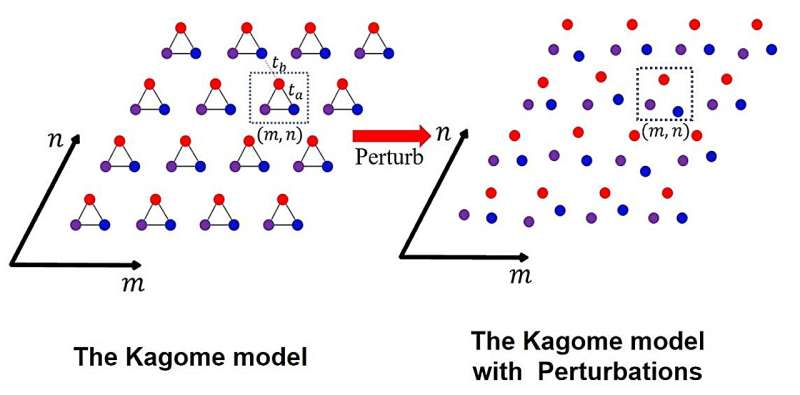
The Kagome model and the perturbations causes the system to disorder. Credit: Frontiers of Optoelectronics (2024). DOI: 10.1007/s12200-024-00113-7
Researchers led by Prof. Xiaoyong Hu at Peking University, China, are interested in topological photonics. They have proposed an interdisciplinary approach to study the topological systems through information entropy (IE) in real space.
The work is published in the journal Frontiers of Optoelectronics.
Topological photonics plays an important role in the fields of fundamental physics and photonic devices. The Kagome model, the Su-Schrieffer-Heeger (SSH) model and the other topological models are used as a platform to study the novel physics phenomenon, and guide to design novel photonic devices such as topologically protected laser and robust transmission device.
Until now, researchers have usually judged the topological states in a photonic crystal based on three criteria: the topological invariant, including Chern Number, winding number and Z2 topological invariant; the eigenvalue distributions or gaps in the band of photonics crystal; and the electric field distributions of the topological states.
Almost all the previous methods rely on the band structures in the momentum spaces. However, it is generally complicated to analyze the topological properties in momentum space, especially if there are perturbations in the system. The perturbations will even cause the bandgap closing of topological system, which will bring difficulty to analyze the topological in momentum space.
The Kagome model is used as an example of theoretical calculation, and the disappearing process of its topological edge states (TESs) is observed with IE. The IE method can be used to analyze the TESs mode distributions and topological phase transition. This method can also be extended to SSH model and the valley-Hall photonic crystal.
The research provides a method to study topological photonic phase based on information theory, and an opportunity to analyze the physical properties by taking advantage of interdisciplinarity.
More information:
Rui Ma et al, Information-entropy enabled identifying topological photonic phase in real space, Frontiers of Optoelectronics (2024). DOI: 10.1007/s12200-024-00113-7
Provided by
Higher Education Press
Citation:
Information-entropy enabled identifying topological photonic phase in real space (2024, May 10)
retrieved 10 May 2024
from https://phys.org/news/2024-05-entropy-enabled-topological-photonic-phase.html
This document is subject to copyright. Apart from any fair dealing for the purpose of private study or research, no
part may be reproduced without the written permission. The content is provided for information purposes only.
>>> Read full article>>>
Copyright for syndicated content belongs to the linked Source : Phys.org – https://phys.org/news/2024-05-entropy-enabled-topological-photonic-phase.html






























